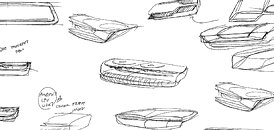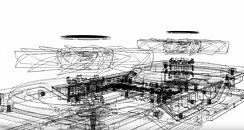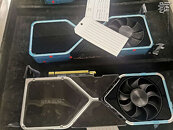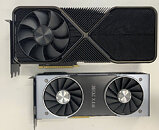Wednesday, August 26th 2020

NVIDIA Shares Details About Ampere Founders Edition Cooling & Power Design - 12-pin Confirmed
NVIDIA today shared the design philosophy behind the cooling solution of its next-generation GeForce "Ampere" RTX 3080 / 3090 graphics cards, which we'll hopefully learn more about on September 1, when NVIDIA has scheduled a GeForce Special Event. Part of the new video presentation shows the evolution of NVIDIA's cooling solutions over the years. NVIDIA explains the four pillars behind the design, stressing that thermals are at the heart of its innovation, and that the company looks to explore new ways to use air-cooling more effectively to cool graphics cards. To this effect, the cooling solution of the upcoming GeForce Ampere Founders Edition graphics cards features an airflow-optimized design focused on ensuring the most effective way to take in fresh air, transfer heat to it, and exhaust the warm air in the most optimal manner.
The next pillar of NVIDIA's cooling technology innovation is mechanical structure, to minimize the structural components of the cooler without compromising on strength. The new Founder Edition cooler introduces a new low profile leaf spring that leaves more room for a back cover. Next up is reducing the electrical clutter, with the introduction of a new 12-pin power connector that is more compact, consolidates cabling, and yet does not affect the card's power delivery capability. The last pillar is product design, which puts NVIDIA's innovations together in an airy new industrial design. The video presentation includes commentary from NVIDIA's product design engineers who explain the art and science behind the next GeForce. NVIDIA is expected to tell us more about the next generation GeForce Ampere at a Special Event on September 1.Although the video does not reveal any picture of the finished product, the bits and pieces of the product's wire-frame model, and the PCB wire-frame confirm the design of the Founders Edition which has been extensively leaked over the past few months. NVIDIA mentioned that all its upcoming cards that come with 12-pin connector include free adapters to convert standard 8-pin PCIe power connectors to 12-pin, which means there's no additional cost for you. We've heard from several PSU vendors who are working on adding native 12-pin cable support to their upcoming power supplies.
The promise of backwards compatibility has further implications: there is no technical improvement—other than the more compact size. If the connector works through an adapter cable with two 8-pins on the other end, its maximum power capability must be 2x 150 W, at the same current rating as defined in the PCIe specification. The new power plug will certainly make graphics cards more expensive, because it is produced in smaller volume, thus driving up BOM cost, plus the cost for the adapter cable. Several board partners hinted to us that they will continue using traditional PCIe power inputs on their custom designs.The NVIDIA presentation follows.
The next pillar of NVIDIA's cooling technology innovation is mechanical structure, to minimize the structural components of the cooler without compromising on strength. The new Founder Edition cooler introduces a new low profile leaf spring that leaves more room for a back cover. Next up is reducing the electrical clutter, with the introduction of a new 12-pin power connector that is more compact, consolidates cabling, and yet does not affect the card's power delivery capability. The last pillar is product design, which puts NVIDIA's innovations together in an airy new industrial design. The video presentation includes commentary from NVIDIA's product design engineers who explain the art and science behind the next GeForce. NVIDIA is expected to tell us more about the next generation GeForce Ampere at a Special Event on September 1.Although the video does not reveal any picture of the finished product, the bits and pieces of the product's wire-frame model, and the PCB wire-frame confirm the design of the Founders Edition which has been extensively leaked over the past few months. NVIDIA mentioned that all its upcoming cards that come with 12-pin connector include free adapters to convert standard 8-pin PCIe power connectors to 12-pin, which means there's no additional cost for you. We've heard from several PSU vendors who are working on adding native 12-pin cable support to their upcoming power supplies.
The promise of backwards compatibility has further implications: there is no technical improvement—other than the more compact size. If the connector works through an adapter cable with two 8-pins on the other end, its maximum power capability must be 2x 150 W, at the same current rating as defined in the PCIe specification. The new power plug will certainly make graphics cards more expensive, because it is produced in smaller volume, thus driving up BOM cost, plus the cost for the adapter cable. Several board partners hinted to us that they will continue using traditional PCIe power inputs on their custom designs.The NVIDIA presentation follows.







143 Comments on NVIDIA Shares Details About Ampere Founders Edition Cooling & Power Design - 12-pin Confirmed
Most GPUs these days are only fast with 32-bit numbers. I'm going to guess that they just have a small PRNG state, so the "tiles" will be small. They're using something higher quality than your typical Unix LCGRNG for sure (see here for LCGRNG patterns: www.reedbeta.com/blog/quick-and-easy-gpu-random-numbers-in-d3d11/).
32-bit cycles go fast (4-billion is pretty small, all else considered), and many PRNGs fail at actually randomizing their bit differences... so you'll get repeating patterns over the 32-bit cycles. Especially if you're seeing the same pattern over and over again? Seems like the seed has just "cycled over" like an odometer.
EDIT: 1920 x 1080 x 8000 samples == 16-Billion samples. Enough to overflow a 32-bit PRNG four times. Just for some napkin math (and each sample may use more than one RNG value in the raytracing). Throw down some low-quality lower bits, and a "pattern" could very well emerge.
Just my opinion on that matter though.
"Ray tracing has two quality settings: high and ultra. Ultra setting traces up to one ray per pixel, with all the denoising and accumulation running in full. The high setting traces up to 0.5 rays per pixel, essentially in a checkerboard pattern, and one of the denoising passes runs as checkerboard. We recommend high for the best balance between image quality and performance, but please note that we are still experimenting a lot, so this information is valid only at the time of writing."
Interview on Metro Exodus with the developer's CTO and rendering programmer
www.eurogamer.net/articles/digitalfoundry-2019-metro-exodus-tech-interview
But the pattern is about where the rays are cast, not about replacing or faking something with some kind of artificial tiles that Crispy is making up. It's not some made up fake thing. They rays still go to those locations, do their thing as normal. They devs are just reducing the number of rays to improve performance.
I'm familiar with pure CPU and GPU raytracers from a career perspective. Whilst I don't actively model and render myself, I'm responsible for budgeting and buying hardware farms for the teams that do, and in 20 years of doing this I've never seen repeating patterns like this, so I'm reasonably certain they're not generated by true raycasts. The various videos by devs on how they implemented DXR are all pretty cool, but I suspect the real secret sauce of what generates these patterns is another Nvidia black box that contains proprietary methods that Nvidia don't want to divulge to the competition. Unless someone finds more official detail, we're left to speculate with the evidence we can gather from the end result.
last time i checked, "you" aim for 1st, not second place..
so you want Nv to do less, just so amd can have something close in performance?
what other product on this planet gets artificially castrated, so competition can catch up?
----
funny how many ppl here "know" with how good one brand will be, and the other will be doing so bad, on cards that havent seen light of day yet,
nor been reviewed.
please make a sign and put it on your fridge:
it could/should/would..
the good thing? it will work for ANY future release of any hw. :D